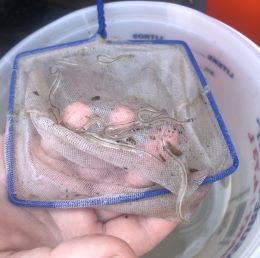Eels Arrive in Hudson Tributary Streams; Webinar on Model Local Laws April 20
The New York State Department of Environmental Conservation sent this bulletin on 04/13/2021 12:04 PM EDT |
| DEC Delivers - Information to keep you connected and informed from the NYS Department of Environmental Conservation |
| Share or view as a web page || Update preferences or unsubscribe |
Hudson RiverNet
|
In This Issue:
Eels Arrive in Hudson River Tributary StreamsAll along the Hudson River Estuary, DEC, teachers, students, and This spring, the eels will be monitored at 10 stream sites along the Hudson River from New York Harbor to the Capital District. Following strict COVID-19 safety protocols to prevent community spread of the coronavirus, limited groups of trained volunteers and students will don waders and venture into tributary streams to check 10-foot cone-shaped nets ("fyke nets") specifically designed to catch this small life-stage of the eel. The eels are gently counted from the net and placed in a bucket of stream water before being released. Most of the eels are released above dams, waterfalls, and other barriers to migration so that they have better access to habitat. Eels will live in freshwater rivers and streams for up to 30 years before returning to the sea to spawn.
Check out this week's Virtual River website for more eel videos and lesson plans. Watch a video about the eel project. Model Local Laws to Increase Resilience Webinar April 20New York’s Community Risk and Resiliency Act (CRRA) became law in 2014 and requires state agencies to assess potential future climate risks related to sea-level rise, storm surge, and flooding when making certain permitting, funding, and regulatory decisions. The 2019 Climate Leadership and Community Protection Act amended CRRA to expand the list of climate hazards to be considered and the permit programs covered by the law. CRRA also tasked the Department of State, in consultation with the Department of Environmental Conservation, with developing model local laws that include consideration of these future climate risks. This webinar, to be presented Tuesday, April 20, 1 p.m. - 2:15 p.m., will introduce CRRA and present the Model Local Laws to Increase Resilience, published in 2019. The Model Local Laws can assist municipalities in making changes necessary for adaptation to climate change, including flooding, stream bank erosion, storm surge and sea-level rise. The webinar will discuss how the Model Local Laws were developed, how to use the resource document, and give examples of model laws that emphasize use of green infrastructure, incorporate natural and nature-based measures, and/or preserve natural features. Presenters include Mark Lowery, assistant director, DEC Office of Climate Change; and Barbara Kendall, coastal resources specialist, DOS Office of Planning, Development and Community Infrastructure.
|

 partner environmental organizations are participating in the
partner environmental organizations are participating in the  Now in its 14th year, the Hudson River Eel Project was initiated by the Hudson River Estuary Program and
Now in its 14th year, the Hudson River Eel Project was initiated by the Hudson River Estuary Program and 